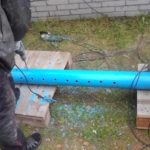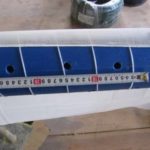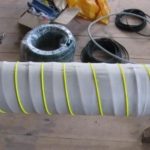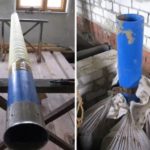Most owners of country houses build an autonomous water supply system on their personal plot, which, undoubtedly, has many advantages. But its content is troublesome. Well water clogging with clay, silt, sand and other foreign impurities is not uncommon. Only filters will help to solve the problem.
How to choose filters for water from a well to remove lime and sand
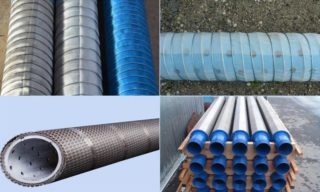
Filters for lime water from a well are divided into several types, therefore, before buying, you should familiarize yourself with the features of each type and selection criteria. Drinking contaminated liquid is unpleasant and dangerous for the human body. In order for the well fluid to always remain clean, and the water supply system not to clog and fail, it is required to install cleaning filters. One of the first signs by which cleaning devices are distinguished is the place of their installation:
- On the surface, they put models that can only cope with small litter.
- Modifications are installed inside the casing for coarse cleaning - removal of large particles.
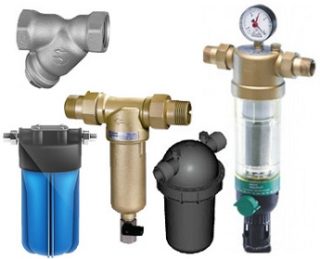
To achieve maximum results, it is recommended to equip the water supply system with two types of filters at once. A third device is also mounted near the water tap, the main task of which is to cleanse the liquid from nitrates, iron and other foreign impurities.
All the simplest models of purification filters are designed to remove clay, sand and silt impurities from water. As a rule, stainless steel is used to make the mesh. The mesh sizes range from 0.12 to 3 mm2. Quite often, such filters are additionally equipped with several layers of mesh with holes of different shapes. Technical features of the devices:
- Reasonable cost and, subject to the rules of operation, long service life.
- Quickly and easily removed for replacement.
- Reduce the productivity of the source, due to the presence of the resistance of the metal and the frequency of the cells.
- They fail quickly when used in wells with a high concentration of iron.
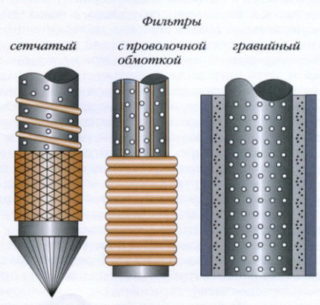
The first advantage of slotted and perforated devices is their compact size, they look like a pipe with a large number of holes. Features of such designs:
- They are installed in the soil, which contains a high concentration of gravel, crushed stone and pebbles.
- Designed for water purification from artesian wells.
- Retain sand up to 2 mm in diameter and large particles up to 1 cm in size.
- The cleaning system is easy to install and durable.
- The soil, which contains a large amount of impurities, sand, etc., quickly clogs holes, so regular preventive flushing is required.
Experts recommend purchasing perforated and slotted filters, additionally equipped with stiffening ribs, this will prevent possible deformation.
Wirewound varieties consist of a body and a tube with holes, as well as a sump. Features of such designs:
- They are installed in casing strings to purify water from artesian and sand wells.
- Some models are not repairable.
- It is often difficult to clean the holes when they are dirty.
- Long service life, high performance.
Gravel filters are designed for additional fluid purification.Installation is simple - sprinkle with gravel and sand on the surface of the well.
There are water filters, the task of which is to disinfect the liquid. These include reverse osmosis systems, ion exchange and ultraviolet installations.
Installation of water purification structures
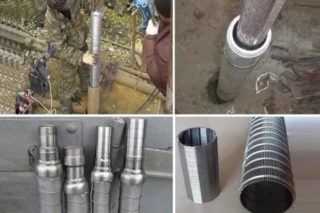
For the first stage of water purification from the source, perforated or slotted purification structures are most often used at home. Their advantages are high efficiency of work and simplicity of execution and installation. Installation algorithm:
- Prepare all work equipment. You will need a pipe made of stainless steel or plastic, a stainless steel or brass mesh equipped with fine meshes, wood cork and a drill with a drill. The pipe diameter should be less than the casing diameter, while the length depends on the depth of the water mirror, but not more than 5 meters.
- On the pipe, measure a section of at least 10 cm. This is necessary for the construction of a sump.
- Just above the site for the sump, markings are made for the perforated part. The holes are placed strictly in a staggered manner, the interval between them ranges from 1-3 cm. The more holes on the canvas, the higher the throughput of the cleaning system.
- Holes are drilled from bottom to top at an angle of up to 60 degrees.
- All dirt and chips are removed, the perforated area is stretched with a mesh. Fixed with rivets.
- On the side of the sump, the tube is closed with a wooden plug.
When installing a water purification system, you need to be aware that the perforated zone should occupy at least ¼ of the total length of the pipe.
How to make a filter yourself
Before proceeding with the manufacture of a purification filter with your own hands, you need to determine which mesh sizes will be the most optimal. This is calculated by trial and error. Fine particles of sand and silt are sifted through the options you like. Preference should be given to the one that has retained at least 50% of the pollution.
Next, you need to make the case. To do this, a wire is wound in a spiral with an interval of 2-3 cm.Using a special soldering iron, it is possible to fasten the case. From the top, a mesh is wound in one layer. Fasten with a special adhesive or welding.
If the task is to make a gravel system with your own hands, at the initial stage you need to select the gravel of the optimal size. As a rule, in its mass, it should be several times greater than the mass of mechanical waste contained in well water. During the manufacture of the system, a bag with a load must be lowered into the bottom extension. After that, tamping, gravel is poured into it.
It is already much more difficult to make a wire type device on your own. In this case, it will be more profitable to purchase a filter of the required diameter and fix it on the perforated section of the previously prepared pipe.
For self-installation of any type of purification filter, it is important, first of all, to determine its throughput. If a person is not sure that he will be able to do all the work with high quality, it is better to entrust it to specialists. As practice shows, excessive savings leads to large waste.

